 I don’t know jack about raising animals – and I don’t think I’m alone. In fact, it can be said (and yes, dozens of people have said, in various terms of disparagement) that I am not an animal person at all.
I don’t know jack about raising animals – and I don’t think I’m alone. In fact, it can be said (and yes, dozens of people have said, in various terms of disparagement) that I am not an animal person at all.
But the great thing about visiting a Heifer International project is that you learn a boatload about animal husbandry, even if you don’t want to. And while that still may not make you feel swoony about cows, pigs, chickens and goats, it certainly gives you new respect for them. It also makes you realize how utterly removed that we westerners are from any and all sources of our food, despite our utter dependence on animals for life itself. In the developing world, you see on a daily basis how important animals are to communities and how closely people live with their animals. The symbiotic relationship between man and beast is tangible and immediate: we simply can’t live without each other.
But let’s get back to the pork…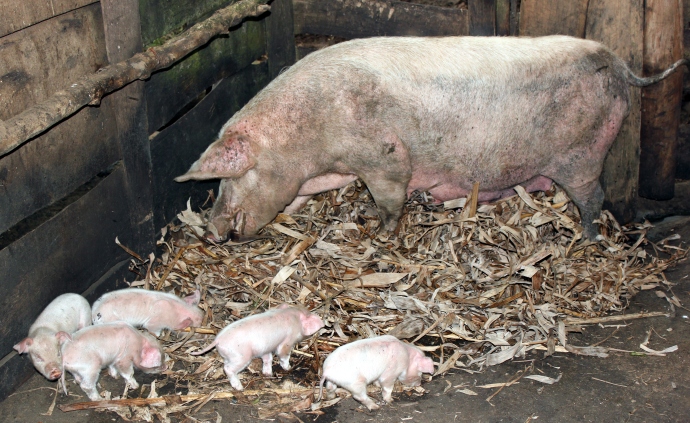 In Uganda, pigs are valued for their meat, their manure, and their ability to produce other pigs – and lots of them. The mommy pig is a sow; the daddy pig is a boar – and piglets can become parents at an astonishing six months of age. Pretty much as soon as they’re weaned, they’re ready to roll. The gestation period for a pig is apparently as precise as a Rolex –and their litters are huge: a sow will often produce 10-15 piglets in one furrow. And they’ll produce at least five farrows in a lifetime. That’s some serious fertility.
In Uganda, pigs are valued for their meat, their manure, and their ability to produce other pigs – and lots of them. The mommy pig is a sow; the daddy pig is a boar – and piglets can become parents at an astonishing six months of age. Pretty much as soon as they’re weaned, they’re ready to roll. The gestation period for a pig is apparently as precise as a Rolex –and their litters are huge: a sow will often produce 10-15 piglets in one furrow. And they’ll produce at least five farrows in a lifetime. That’s some serious fertility.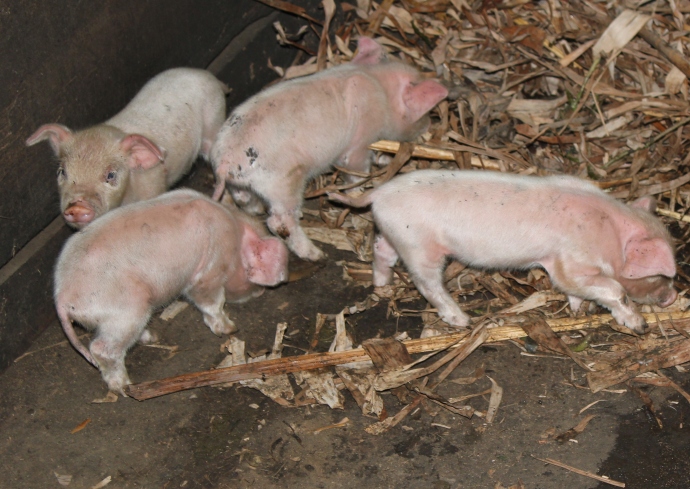 Almost as precious as piglets is pig poop …which can be used to fertilize banana plants, maize, coffee, potatoes, cassava, and all kinds of fruit trees. When you’re raising everything you eat, and there are no stores in the event you run out of Hot Pockets, a better crop isn’t just a luxury, it’s a lifeline. And poop makes a huge difference.
Almost as precious as piglets is pig poop …which can be used to fertilize banana plants, maize, coffee, potatoes, cassava, and all kinds of fruit trees. When you’re raising everything you eat, and there are no stores in the event you run out of Hot Pockets, a better crop isn’t just a luxury, it’s a lifeline. And poop makes a huge difference.
Heifer trainings teach farmers how to compost in six trenches: plant and food scraps are turned over and moved from one trench to the other over the course of weeks, until the sixth one produces beautiful composted soil, ready to be mixed with manure & used as fertilizer.
To produce this glorious rot, pigs eat banana peels, napia grass, elephant grass, food scraps and peels. The farmers must learn to plant and grow the food the pigs need to eat – which is another Heifer training. And farmers need to carefully cross-breed the pigs, so the pig stock remains strong and there isn’t an issue of in-breeding. The Heifer extension workers carefully chart the breeding and bring in boars from surrounding communities to protect the genetic integrity of the animals.
It’s a complicated thing, raising pigs. Particularly when you have to do every single part of it yourself: build the shed, raise the plants to feed the animal, breed it, milk it, sell it, slaughter it, and use its poop to grow more food for your family (and for your animals).
Bringing home the bacon is both remarkably complex and utterly essential.

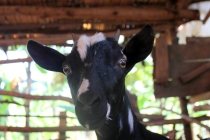
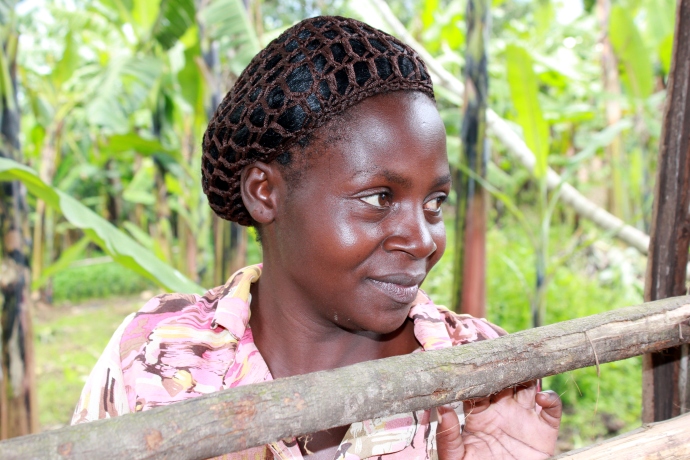


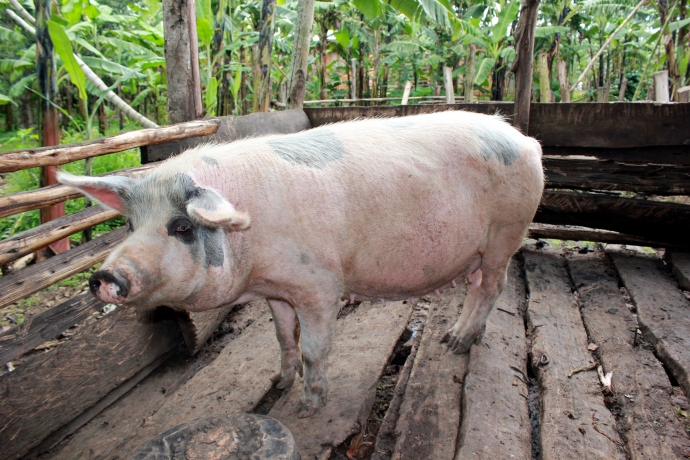




Is there anything more interesting than cultures of other countries? Who would ever think of a pig as a treasured possession and a lifeline for some families in foreign countries?
Your blog offers a refreshing educational read.
Ronnie
Thanks Ronnie! And you are so right in describing a pig as a treasured possession. The Heifer beneficiaries will work for 3-6 months to prepare to get the animal — and even buying the nails to build the shed sometimes requires great sacrifice on the part of the families — but it’s an incredible gift, and the people are very VERY excited to receive an animal that can earn them income, provide nutrition for their families, and increase their crop yields significantly. It’s a real sign of status .. and then, they have the opportunity to be givers themselves, and pass along the gift — which I will get to see in a ceremony in Guatemala next week!!! Thanks for the comment!
This is really going to work, Betty–you are funny and very honest and teach us a lot about Heifer’s work, in simple and straightforward contemporary conversations. I must say, you answered my mental query/feelings about your personal “relationship” to animals and why the hell you were going to traipse all over the world telling us about livestock. It’s already adorable.
Okay, Anonymous — I don’t even know who you are, but obviously, you know EXACTLY who I am, since you wondered deeply about the authenticity of me writing about animals! Now that you can clearly see I’m not going to fake loving all the cute little bunnies (I can’t stand them! those beady pink eyes! those frightening long ears!!!) … I’m glad you’re along for the ride! It’s going to be EPIC! xoxoxo b
Great story…we take so much for granted in the US.
Keep the stories coming. I love reading them!
Thanks, Denise — I’m just getting started!! (:
Living in the developing world changed my relationship to food, for sure. We are absolutely insulated in the West–sadly and blindingly so.
The piglets are darling.
Kathy
Hi Kathy! Thanks for the insightful comment — and yes, it really does strike you how we never even think of animals (except our dogs and cats) in this country, and they literally give their lives for our survival. Kinda makes even a cranky non-animal lover like me a bit sad…
Vokhjuyn,chnayadz nakhndrum em asel Barev DzezQo Yekamuty Internetum Dprocy,mi bricaak yerevuyt er ays jamanakahatvazum,bari bun imastov.shnorhakalutyun em haytnum bolor ayd mardkanc ,lini gaghabari,kazmakerpchakan kam matucman arumov voronq iskapes nvirvadz mshakel en u matucum en ayd ameny inch vstahutyun knershnji apagayi handep.Hajoghutyun em tcankanum bolorin.
Piglets, Hot Pockets and poop!
Education through entertainment, you are the best…can’t wait for your posts.
Can’t wait to get started, Laurie!!! xoxoxo b
OK, Betty, you got me. Not with the cute pictures of piglets, not even with your fresh witty writing, but because you are the real deal. You are someone who expands your horizons by expanding your compassion, and because you bring so much much joy and humanity to this journey, we can’t HELP but want to join you for the ride. I could not resist your most recent 365 blog. Now you have to check out my blog…http://yasminazaidman.wordpress.com/
Yasmina, you are the BEST, and I can’t wait to read your blog! I’ve loved your ruminations on motherhood and women’s work of all sorts … AND of course, Acumen is one of my favorite organizations EVER! Thanks for the comment!!
When I was a girl in Pennsylvania, my friend Cindy raised prize-winning pigs. She took them to the Farm Show where she showed them with inestimable pride. Cindy loved those impressive animals, and I too grew to appreciate their intelligence and loyalty.
Love this story of pigs…and your familiarity with them (go Cindy!). Thanks for the piggy-appreciation!!
back to basics ain’t for the faint of heart! Enjoy your ambassador-ship!
Thanks so much — and luckily, back to the basics works for me (at least for a week or two!!) Cheers, B
My ancestors have raised pigs in Iowa for over 100yrs!! I can not tell you how many summer mornings at my aunts I would find baby pigs warming in her oven because they ere the runts. I have hand fed many piglets til they were big enough to fight their siblings. It is an absolutely wonderful cause that isn’t just handing someone something, but teaching them a whole new way of living for their benefit!! Wish we could take some of our welfare recipients and give them a better way to live for themselves. I am anxiously waiting to here about your travels this yr!!
DEb, I had no idea you were such a country girl! Your stories remind me of Charlotte’s Web!! I agree that one of the real strengths of Heifer is its longstanding mission to help people to be self-sufficient, independent and able to support themselves and their families, which is what the gift of an animal and all the Heifer trainings offer. That is where the dignity of life comes in … as well as building a strong community. Thanks for writing!!
Thanks for giving us perspective Betty–one that I would not have.
I imagine the warm weather there makes parasites particularly a problem; with the pigs in such makeshift enclosures and without vet care.
I hope you have a nice weekend.
Hi SD! Actually, because Rikinguri is in the highlands of Uganda, the weather is not oppressively hot (at least it wasn’t when I was there in the end of October) — and keeping the animals in sheds is a very good way for them to stay parasite free, clean, and in a place where collecting their manure for fertilizer is quick and simple. The Heifer extension workers are VERY well trained in animal husbandry and act as vets and counselors for the people — and they come by to inspect the animals on a regular basis to see how healthy they are, and intervene if they are looking sick. The sheds protect the animals from the weather, keep them from rooting through valuable crops, and exercise yards keep them active!
Reblogged this on Ann Novek–With the Sky as the Ceiling and the Heart Outdoors.
I love reading about where you’re going and what Heifer is doing. And the picture of the piglets just reconfirms that my runt dog Jack looks a lot more like a piglet than a dog.
JM! I couldn’t believe how cute those little piggies were … but I think a dog named Jack sounds pretty big and manly (unless he’s a terrier???) I’m really jazzed about being here in Guatemala and can’t wait to post!!
Your pig facts are not quite accurate. SInce I am a “farm girl”, I’d like to correct a few things you wrote in your blog. Pigs don’t “furrow”, they “farrow”! The process of giving birth is called farrowing. And I don’t know of any pigs that are ready to give birth at 3 months. Here in the U.S., they are at least 6 months, and usually 71/2 to 8 months before they are even bred, which means they won’t farrow until 10 to 12 months of age. Boars normally need to be at least 8 months before they are used for breeding. So while pigs are great for providing a source of protein for families, they don’t do it quite as quickly as you stated. Great photos!
Judy
Judy! I am going to make these changes right now! I am SO happy a true farm girl can weigh in on this … and I really am happy for your comments!! (i’m wondering if my translator got the months number wrong??) THANKS!!
Fantastic work, my new friend!
Thanks, Hook — you know, I was so madly in love with Uganda … and these piglets were only PART of the story. The people just stole my heart!!
Bet, somehow I missed the beginning of this 12×12 journey…but I’m on board now. Catching up on every precious word and picture and ready for the ride!
Lori … So happy you’re on board, and can’t wait to take you along with me … just love hearing from you & staying in touch! xoxoxo b� Betty Londergan 2702 Mabry Rd. NE Atlanta, GA 30319 (610-348-9279) https://heifer12x12.wordpress.com
________________________________
Betty,
Thank you for sharing once again. I will follow you wherever you go. It is a blessing an an honor to call you a friend.
Sorry I did not show my name. Here I am Betty.